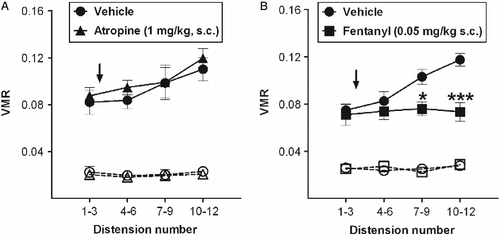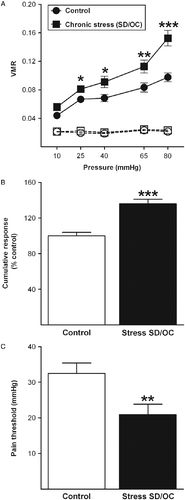Figures & data
Figure 1. Timeline of the experimental procedure. A variable chronic social stress (social defeat and overcrowding; SD/OC) paradigm was applied for 19 days. On Day 20, to assess the effect of chronic psychosocial stress on visceral and somatic nociception, mice were tested with CRD (with ascending distension from 10 to 80 mmHg), and the HP test, respectively. To evaluate the impact of psychosocial stress on social interaction or avoidance behaviour, 24 h after the last stress session, mice underwent the Social Interaction Test (SIT) followed by faecal pellets collection. Separate cohorts of mice were used for each behavioural test to avoid additional confounding factors. To study the effect of SD/OC on body weight, mice were weighed on days 1, 3, 8, 10, 15 and 19, before each stress session (indicated by arrows). Additionally, some control and SD/OC mice were killed at the beginning of the dark phase (20:00 h) to determine the effect of psychosocial stress on thymus weight, adrenal weight and plasma corticosterone concentrations.

Figure 2. Effect of atropine and fentanyl on the VMR to repeated CRD. (A) The muscarinic antagonist atropine did not alter the VMR (expressed as pressure changes in the balloon in response to CRD) and (B) the μ-opioid receptor agonist fentanyl prevented the sensitizing response to repeated CRD (12 × 55 mmHg). After a first group of three distensions, vehicle, atropine (1 mg/kg) or fentanyl (0.05 mg/kg) were administered subcutaneously (indicated by the arrow) and nine additional distensions were performed. The broken lines represent the basal activity. N = 7–10 mice per group. Data are expressed as mean ± SEM. *p < 0.05 and ***p < 0.001 vs. control mice (RM-ANOVA).

Figure 3. Chronic psychosocial stress alters the visceral sensitivity to CRD. (A) Chronic SD/OC induced increased visceral pain responses 24 h following the last stress session. The increase in the VMR (expressed as pressure changes in the balloon in response to CRD) in the stress group was significant for distension pressures of 25, 40, 65 and 80 mmHg, compared with the control group. The broken lines represent the basal activity. (B) Overall response to CRD. Values are expressed as percentage change of control group (set as 100%). SD/OC mice showed a significant increase in the overall response to CRD when compared with the control group. (C) Pain threshold to CRD. SD/OC mice exhibited a significantly lower pain threshold to CRD, compared with the control group. N = 12 mice per group. Data are expressed as mean ± SEM. *p < 0.05, **p < 0.01 and ***p < 0.001 vs. control mice (two-tailed Student's t-test).

Figure 4. Chronic stress-induced physiological changes. Mice subjected to chronic SD and OC showed a significant decrease in the number of faecal pellets, 24 h following the last stress session. N = 13–14 mice per group. (B) Daily body weight changes. SD/OC mice showed a significant increase in body weight over days compared with control mice. (C) Body weight gain. SD/OC mice gained significantly more body weight by the end of the SD/OC procedure (calculated as the difference between Day 19 and Day 1). N = 37–38 mice per group. (D,E) Relative thymus and adrenal weights [expressed as tissue weight (mg) per body weight (g)]. SD/OC mice show significantly reduced thymus weight (D) and increased weight of the adrenals (E). (F) Dark-phase plasma corticosterone concentrations. SD/OC mice showed significantly lower levels of plasma corticosterone than the control group. N = 14 mice per group. Data are expressed as mean ± SEM. *p < 0.05 and ***p < 0.001 vs. control mice (two-tailed Student's t-test).
![Figure 4. Chronic stress-induced physiological changes. Mice subjected to chronic SD and OC showed a significant decrease in the number of faecal pellets, 24 h following the last stress session. N = 13–14 mice per group. (B) Daily body weight changes. SD/OC mice showed a significant increase in body weight over days compared with control mice. (C) Body weight gain. SD/OC mice gained significantly more body weight by the end of the SD/OC procedure (calculated as the difference between Day 19 and Day 1). N = 37–38 mice per group. (D,E) Relative thymus and adrenal weights [expressed as tissue weight (mg) per body weight (g)]. SD/OC mice show significantly reduced thymus weight (D) and increased weight of the adrenals (E). (F) Dark-phase plasma corticosterone concentrations. SD/OC mice showed significantly lower levels of plasma corticosterone than the control group. N = 14 mice per group. Data are expressed as mean ± SEM. *p < 0.05 and ***p < 0.001 vs. control mice (two-tailed Student's t-test).](/cms/asset/99a204cb-f0bf-4588-94b2-dfba370fa207/ists_a_622816_f0004_b.gif)
